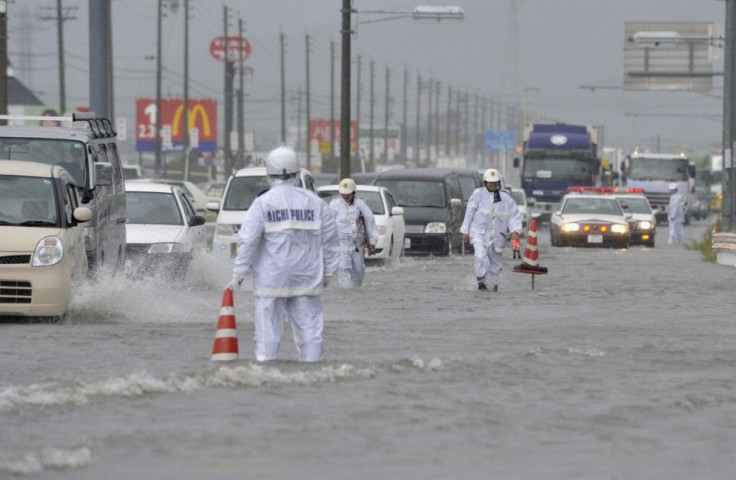Typhoon Roke: Japan Storm Moves Toward Pacific

Typhoon Roke is moving off shore and toward the Kuril Island archipelago between Japan and Russia, according to reports. The storm is still pounding central Japan with rain, including the area around the Fukushima nuclear power plant, which has so far avoided any major damage.
Mud and landslide risks are still in effect in the northeastern region surrounding Fukushima. Hundreds of domestic and international flights have been cancelled and a number of lines on the country's bullet train have been suspended.
Additionally, the 100 mile per hour winds left at least 13 people dead or missing. Complicating matters, a 5.3 magnitude earthquake struck the country on Wednesday near the damaged nuclear plant, but it thankfully had a negligible effect.
Typhoon Roke is currently a category two storm, with winds peaking slightly above 100 miles per hour. As it travels over land, it is expected to ease to a category one.
But don't let the downgrade fool you: Typhoon Roke will still be a deadly, severe storm, and likely not the final one to hit the country this year.
“The thing is just rocketing,” Jim Andrews, senior meteorologist at AccuWeather Inc., told BusinessWeek. “At that speed it doesn't take it long to leave an area the size of Japan.”
Once it moves further into the ocean, meteorologists predict that it will lose intensity as it moves across the Pacific and will be a tropical storm by the time it brings rain to British Columbia, Canada (if it stays on its current path).
Roke is the second biggest Typhoon to hit Japan this month. Three weeks earlier, Typhoon Talas struck the west side of the island nation, killing more than 60 people. Talas was the deadliest storm to hit Japan in seven years.
The severity of a tropical cyclone is labeled according to the Saffir-Simpson Scale, which grades according to wind speed and storm surge. Surge is the essentially the height of a wave, or the measurement of the rise of water due to the storm. The Saffir-Simpson system does not take into account the physical size of a storm, nor the amount of precipitation.
The tropical cyclone scale ranges -- low to high -- from category one to category five. Anything lower than category one, which begins at 74 miles per hour winds and a 4-foot surge, isn't considered either a hurricane or a typhoon. Each category rises incrementally in both qualifiers, until it reaches category five, which is designated by winds of over 156 miles per hour and ocean swells above 18 feet.
Technically, a typhoon is the same thing as a hurricane. On the simplest level, a hurricane is a tropical cyclone that occurs east of the International Date Line (toward the Atlantic), and a typhoon is a storm that happens on the other side of the Date Line in the west Pacific.
Despite the fact that hurricanes and typhoons are the same, typhoons, historically, can be much more powerful than hurricanes. The strongest hurricane ever was Hurricane Wilma in 2005 (during the season that included Hurricane Katrina) with winds reaching 185 miles per hour.
The strongest typhoon ever was Typhoon Tip in 1979, during which winds topped out at over 300 miles per hour. This again is related to geography: the Pacific Ocean is simply larger than the Atlantic, giving the storm more time and room and to grow in intensity.
© Copyright IBTimes 2025. All rights reserved.





















